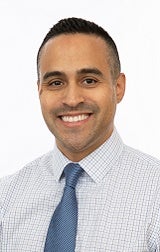Diversifying the United States Physician Workforce: A Matter of Necessity
September 30, 2022In the United States, 19% of the population is Latino, and in California, that number is almost 39%. However, only 6% of physicians in the United States identify as Latino or Latina. This month is National Hispanic Heritage Month and for the first time, National Latino/a Physician Day will be celebrated on October 1. This day was created to bring awareness to the critical shortage of Latino/a physicians in the United States. There are significant health care barriers, inequalities and poorer outcomes in the Latino/Latina/Latinx/Hispanic patient population which has worsened due to the COVID-19 pandemic.
Addressing these disparities is an urgent matter. With approximately 19 million Latino children in the United States -- 26% of the nation's total child population -- motivating the next generation to help diversify the physician workforce is essential.
One person leading advocacy efforts for the diversification among physicians is Valley Children’s Pediatric Hand and Upper Extremity Director Dr. Michael Galvez. He is not only part of the 6% of physicians in the United States who identify as Latino or Latina, but he is also double board certified in plastic and hand surgery.
“I truly believe that one’s upbringing and cultural background, is the foundation to how a physician will provide care to patients,” explained Dr. Galvez. “My parents are from Lima, Peru where my grandfather was a pediatric surgeon. He wasn’t able to practice medicine in the United States, so even though I grew up without health insurance, I had the privilege of having him take care of us, as well as having someone like him to look up to. All of my experiences help my communication with patients, allow me to relate to the families I encounter every day and give me the chance to connect with a broad range of people -- essential to providing quality care.”
From community college, undergrad and medical school, to residency and then two different fellowships, Dr. Galvez continued his higher education through to the “thirtieth grade” as he calls it – a total of 18 additional years of schooling to become the sub-specialized surgeon that he is today. He now serves the Central Valley and provides comprehensive pediatric upper extremity care to kids.
Despite several diplomas in his office, Dr. Galvez said, “What I value most is what I can provide to my patients through effective communication which board certifications do not measure. Trust isn’t something that is just given to me as a doctor, so it is important for me to find a way to genuinely connect, explain and then present the care options to my patients. I am also hopeful that my experience motivates other Latinos to pursue the medical field because the community needs them.”
The Accreditation Council for Graduate Medical Education (ACGME) is the body responsible for medical and surgical training in the United States. They recognize that increasing diversity in the physician workforce positively impacts health care access and patient outcomes. As an advocate for diversification among physician workforce, Dr. Galvez founded the National Latino/a Physician Day on October 1, established to create awareness of the need for more Latinos in medicine. He has worked closely with Dr. Cesar Padilla, an obstetric anesthesiologist at Stanford University, along with many Latino/a physicians from around the country to take on this advocacy effort.
The movement gained traction with the launch of a custom t-shirt campaign commemorating the inaugural year of this effort and raising thousands of dollars to MiMentor - a non-profit aimed at helping underserved students enter medicine. Other influential organizations, such as the National Latino Medical Student Association have also launched successful t-shirt campaigns and celebrations for National Latino/a Physician Day will take place across the country.
“6% is not enough,” added Dr. Galvez. “So my advice to medical students is to ask for help which means being assertive and finding reliable mentorship from someone with a similar socioeconomic background and who has faced challenges they can relate to. Students need specific advice, and the best place to get it is from somebody who has lived it.”
National Latino/a Physician Day represents an urgent “call to action” for the community, hospitals, academic medical centers, educators and legislative leaders, to incorporate structural changes to improve Latino/a representation in the United States physician workforce. Several Latino medical associations and major national organizations including the American Medical Association have sponsored National Latino/a Physician Day.
Learn more on how to support Dr. Galvez and his collaborative work to improve diversification in medicine by visiting National Latino/a Physician Day, and follow social media hashtags such as #nationallatinophysicianday #nationallatinaphysicianday.
About the Author
Valley Children’s Pediatric Hand and Upper Extremity Director Dr. Michael Galvez. He is board certified in plastic and reconstructive surgery, Dr. Michael Galvez joined the Valley Children’s plastic and reconstructive surgery team in 2019 with specialized training in congenital hand deformities and upper extremity surgery. Dr. Galvez has done extensive research in plastic and hand surgery; he has been published in various abstracts, chapters and peer reviewed publications including Plastic and Reconstructive Surgery and the Journal of Hand Surgery.
